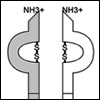Session Overview

|
This session will introduce basic ideas of metabolism, Gibbs free energy, biochemical reactions, enzymes and ATP as the energy currency. Learning Objectives
|
Session Activities
Lecture Video
Watch the lecture video excerpt
Check Yourself
Question 1
If the ΔG of a reaction is negative, which of the following is a true statement?
Question 2
Choose an ending that makes the following statement true. “In an enzyme catalyzed reaction…”
Question 3
Which of the following statements is true with respect to ATP? ATP is commonly used in coupled reactions1. The hydrolysis of ATP is an endergonic reaction 2. The hydrolysis of ATP produces inorganic phosphate and ATP. 3. ATP is used as an energy source and a building block in RNA. 4. ATP can donate a phosphate group that becomes covalently linked to a protein.










